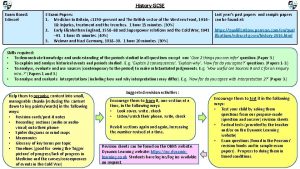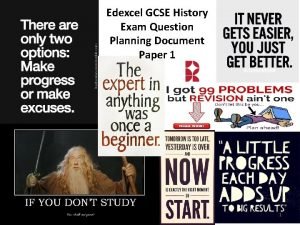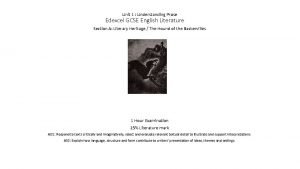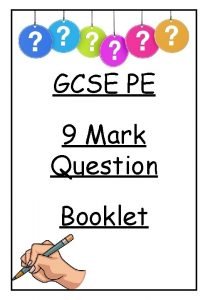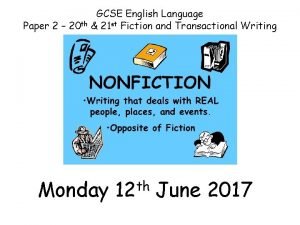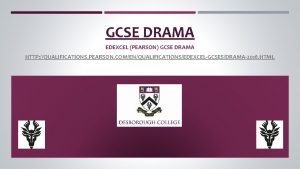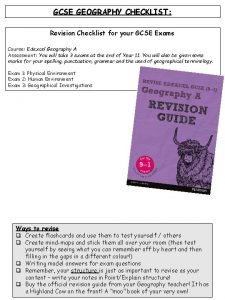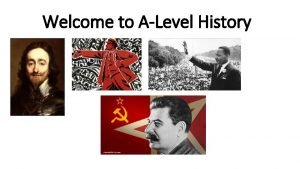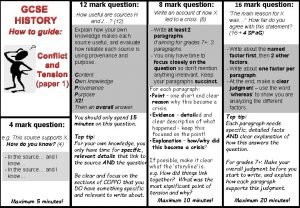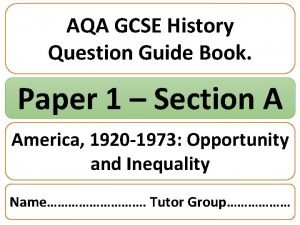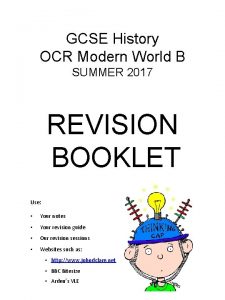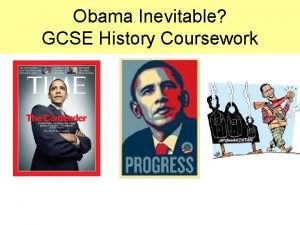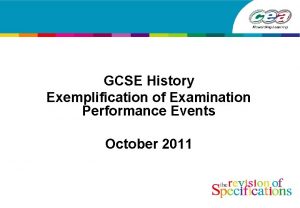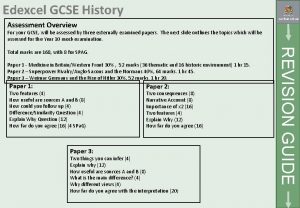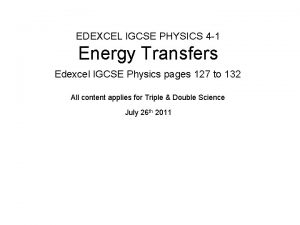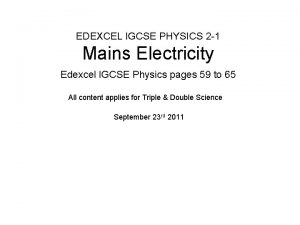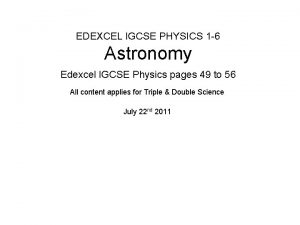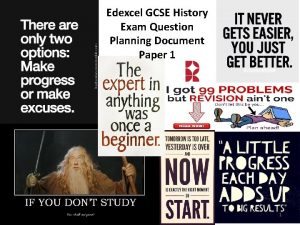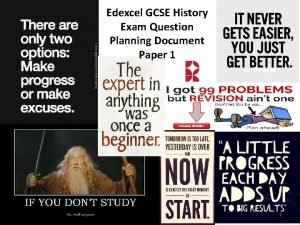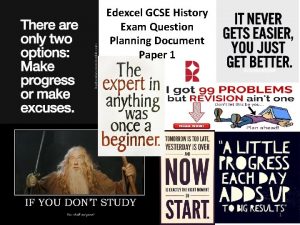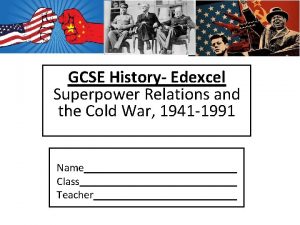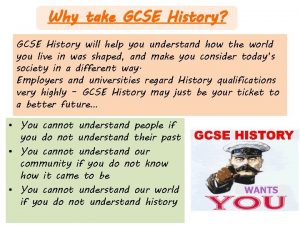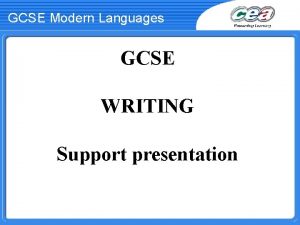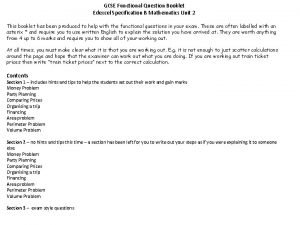Edexcel GCSE History A The Making of the















































- Slides: 47

Edexcel GCSE History A: The Making of the Modern World Unit 1 Peace and War: International Relations

SECTION 5: DEVELOPMENT OF THE COLD WAR

Key Features of Cold War • Arms race – America had dominated the arms race during the 40 s and 50 s, and by 1961 had 20 x as many nuclear missiles as the USSR. They also had the CAPABILITIES to launch these weapons across the Atlantic ocean to reach the USSR. Russia had much smaller nuclear stockpiles and didn’t have the launch capabilities. However they desperately tried to keep up with the US • Military alliances formed – e. g. NATO Pact 1955 1949, the Warsaw • Propaganda – justified government spending on defence, especially in Russia whose economy was bankrupt and couldn’t afford to be developing atomic weaponry

3 Conferences Stalin, Roosevelt and Churchill • Tehran 1943 – the war had not ended yet, but the leaders of the Allied nations met to discuss what would happen to Europe at the end of WW 2. Agreed: USSR would have a sphere of influence, and Stalin agreed to help the other Allies to fight Japan Not agreed: what to do with GERMANY. Stalin wanted the Germans to pay a huge fine called reparations payments, but the UK and USA wanted to rebuild Germany, believing that if Germany prospered it wouldn’t fall to communism and would also make a good trading partner. Soviet sphere of influence An area in which communism would be respected – Stalin would use this as a ‘buffer zone’, i. e. the belt of communist states around Russia would separate the USSR from and defend them against capitalism

3 Conferences Stalin, Roosevelt and Churchill • Yalta 1945 – the leaders met again: Agreed: • Establish a communist government in Poland • Set up the UN, an international body that aimed to achieve world peace • Confirm the USSR’s sphere of influence • Split Germany into four zones, each occupied by an allied nation Disagreed: • The nations agreed to work for democracy in order to liberate Europe, however they had ideological differences on how this would work. Stalin believed that a democratic nation must be a state-led, communist nation, because then power was distributed equally among the classes. However Roosevelt and Churchill believed that democracy involved free elections and a choice of who to elect into power.

3 Conferences Stalin, Truman and Attlee • Potsdam 1945 – meeting for a final time after Germany had surrendered, the ‘Big Three’ disagreed over the issue of reparations. • The leaders agreed each nation could take what they wanted from the zone they occupied, knowing that Stalin would take the most from his zone because he was pretty keen on taxing Germany. But Stalin complained that his zone (East Germany) had much less industry, so was entitled to 25% of industrial equipment from West Germany – occupied by France, the UK and the USA.

Why was there tension at Potsdam? • The Atomic Bomb Truman was arrogant because the USA had just tested its first atomic bomb, without telling Stalin. He thought this gave him power over the other leaders. • Poland Stalin had promised that the government in Poland would be democratic and would have capitalist parties to represent different political ideologies – however he had broken his word and was establishing a communist government.

The Long and Novikov Telegrams • The Long Telegram: the American ambassador to the USSR sent news that Stalin wanted to destroy capitalism and did not want peace with the West. • The Novikov Telegram: the Russian ambassador reported that America wanted world domination and was preparing for war. These reports were both forms of propaganda and so exacerbated the extremity of the situation.

The Truman Doctrine/ Marshall Aid • Truman announced, in a speech that became known as the Truman Doctrine, that the USA had to fight for liberty where it was threatened, and that communism should be fought. • He would loan $13 billion to help European economies rebuild themselves after WW 2. Poor finances made communism seem more appealing as it involved the sharing of resources, and Truman wanted to encourage prosperity to strengthen Europe against this. This was known as the Marshall Plan. • The idea that communism should not be allowed to spread is called containment.

Cominform and Comecon • Cominform, 1947 – an international body set up to represent communist parties across Europe. It: - ensured the loyalty of communist governments - encouraged strikes and demonstrations against America’s plans for Marshall Aid - ultimately, consolidated Stalin’s power • Comecon, 1949 – Stalin’s answer to Marshall Aid. He encouraged communist states to boycott Western aid and accept economic help from Comecon. This isolated prosperity within the Eastern Bloc and meant that the West had little influence in communist states. Eastern Bloc = Warsaw Pact countries, Stalin’s communist buffer states

Bizonia - 1947 • The British and American zones of Germany were, by 1947, basically operating as one and so they merged. Their shared zone became known as Bizonia. The governments of Bizonia and the French zone got on very well. Stalin was jealous that he was isolated (albeit by his own doing). He also believed that Marshall Aid was an attempt for the USA to gain influence in the Eastern Bloc and undermine communism.

The Berlin Blockade and Airlift • In attempt to prove that a divided Germany would never really work, in 1948 Stalin cut the West off from Berlin, it’s capital, by imposing a military blockade around the city. • Truman’s non-aggressive response was to transport thousands of tonnes of supplies into Berlin by air. It went on for several months and eventually Stalin gave up having achieved nothing. This was a propaganda failure for the USSR.

NATO, 1949 • NATO – standing for the North Atlantic Treaty Organisation – was a military alliance set up to unite the USA and many countries in the west of Europe against communism. These countries benefitted from Marshall Aid and promised to help each other in the case of war. • The Warsaw Pact was set up in 1955 as an alliance of Eastern Bloc countries.

The Hungarian Uprising, 1956 Why Hungarians were unhappy: - They lived in a communist dictatorship under ‘Stalin’s best pupil’ Matyas Rakosi - Their land was being redistributed to other communist countries - Their crops were being sold abroad while Hungarians were left starving - Alternative political ideology was strictly illegal - Popular political leaders were executed by Cominform - The secret police helped stamp out opposition

The Hungarian Uprising, 1956 What was De-Stalinisation? Khrushchev knew he couldn’t follow in Stalin’s footsteps. Despite his brutal regime, Stalin’s cult of personality had allowed him to go down in history as a great leader. Khrushchev made what he called the Secret Speech in 1956, which denounced Stalin and promised an end to his style of rule throughout the USSR. What were the effects of this? Students rioted on the streets of Budapest, so violently that the police lost control. They wanted an end to oppression. To appease them, Stalin appointed Imre Nagy as Hungary’s new leader.

The Hungarian Uprising, 1956 Imre Nagy turned out to be much more liberal than Stalin had thought, and proposed the following reforms: - Hungary should leave the Warsaw Pact and seek UN protection from Stalin - Hungary should become a democratic country with free elections - Hungary should become neutral - Hungary should no longer be a communist state

The Hungarian Uprising, 1956 Khrushchev did not take kindly to Nagy’s plans. Intelligence reports had revealed widespread discontent under communism, and Khrushchev feared that if Hungary were allowed to leave the Warsaw Pact this would trigger a ‘domino effect’, whereby many other satellite states would do the same. However Khrushchev did, on Nagy’s request, remove Soviet troops stationed in Budapest for a short space of time.

The Hungarian Uprising, 1956 November 1956: 200, 000 Soviet troops sent into Budapest – 2 weeks of bitter fighting ensues, killing and injuring 20, 000 Hungarians Khrushchev regains control • Nagy executed in 1958, as a lesson to other socialist leaders • Janos Kadar appointed as new leader. He didn’t really have much power, however he did issue a fifteen-point programme that sought some more moderate reforms, many of them reversals of Nagy’s change such as promising to stay in the Warsaw Pact, but there were some positive ideas including the negotiation of the withdrawal of Soviet troops at the end of the crisis.

1. Demonstrated that whilst America wanted to liberate European communist states, they would not offer military help. 2. The USA condemned the fighting and offered economic aid, but they were caught up in the Suez Crisis in Egypt so could offer little military support to the Hungarian people. The USA were also trying their best not to allow war to break out, knowing it would be nuclear. Effects of the Hungarian Uprising, 1956 4. Also, as the West had not intervened, other Eastern European radicals were dissuaded from protesting. 3. Khrushchev consolidated his control over the Eastern Bloc and showed the leaders of satellite states that they had little power.

SECTION 6: COLD WAR CRISES

THE BERLIN CRISIS Key facts: • Between 1949 and 1961, 2. 7 million East Germans fled West to escape communism • This resulted in a mass-loss of skilled workers, professionals and intellectuals for the Soviet government • This was a propaganda for Khrushchev as it demonstrated communism’s lack of popularity • Many East Germans would work in the Western half of the city, and could pass freely between the zones

THE BERLIN CRISIS 6 -month Ultimatum Khrushchev’s solution to the refugee crisis was to present President Kennedy with an ultimatum – remove American troops from Berlin or war will be declared. Khrushchev wanted total control of Berlin, which at the time was divided between the East and the West even though it was in the Soviet zone.

THE BERLIN CRISIS 4 Summits – Kennedy proposed that the two leaders met and discussed Berlin, and so Khrushchev dropped his ultimatum 1. Geneva, 1959: Khrushchev and Kennedy met and were able to talk face to face – however they couldn’t agree on a solution. 2. Camp David, 1959: again, the leaders met but could come to no decision about Berlin. 3. Paris, 1960: on finding out that an American spy plane had been shot down over the USSR, Khrushchev was furious and stormed out. 4. Geneva, 1961: Khrushchev brings back his ultimatum, prompting Kennedy to prepare the USA for nuclear war. He spent hundreds of millions of dollars on defence, including nuclear fallout shelters.

THE BERLIN CRISIS However, Khrushchev knew he couldn’t win a war with the USA. In 1961, the Americans had 20 times as many nuclear weapons as the Soviets, as well as B 52 bombers which gave them launch capabilities. Khrushchev’s next move was to build a physical barrier dividing East Berlin from the Western half. The wall was guarded by troops and people were no longer allowed to pass across the border. Built on the night of the 12 th August 1961, the wall started off as a barbed wire fence but evolved into a heavily-guarded, fortified wall that symbolised the Iron Curtain. Those who attempted to cross the border unauthorised were simply shot. Kennedy visited West Berlin in 1963, and made his ‘Ich bin ein Berliner’ speech. His response to the situation was that ‘A wall is a hell of a lot better than a war’.

THE CUBAN MISSILE CRISIS Cuban Revolution, 1959 Led by Fidel Castro, the Cuban people overthrew their royal family in 1959, and their new government was later to reform as communist. The new government assumed ownership of all American property on the island. As a result, the Americans imposed a trade embargo on Cuban sugar, which was a huge knock to the Cuban economy which relied heavily on its exports. Castro asked Khrushchev for help, and the Soviet leader jumped at the chance of having an ally so close to his enemy, the USA. The Bay of Pigs, 1961 The USA wrongly assumed that the Cubans were discontented with their government and support a counter-revolution. Eisenhower had plan to solve the problem by assassinating Castro, but when Kennedy came into power in 1961 he planned to train Cuban refugees with the CIA and then send them into Cuba’s Bay of Pigs to revolt. However the USA had miscalculated and the Cuban people fought for their government, defeating the American forces within 2 days.

THE CUBAN MISSILE CRISIS As a result of the invasion Castro felt Cuba was vulnerable to another attack from the US and sought military protection from the Soviets. Khrushchev saw this as the perfect opportunity to place his missiles within the American sphere of influence. This way he didn’t need to spend enormous amounts of Russian money on developing the capabilities to launch missiles across the Atlantic Ocean. In September 1962 Khrushchev began shipping Soviet missiles into Cuba, unbeknown to the Americans until one month later. In late October, Kennedy addressed the USA informing them of Khrushchev’s plans.

THE CUBAN MISSILE CRISIS The Thirteen Days What ensued were thirteen days of extreme tension between the two nations in a bid to avoid going to war. • Kennedy hears of Khrushchev’s plans • Kennedy announces an American naval blockade around Cuba • Khrushchev declares Soviet ships will break the blockade, and says the USSR is prepared to launch nuclear weapons if the USA goes to war • Both sides prepare for war • Kennedy asks that Khrushchev withdraws his missiles from Cuba • Khrushchev agrees in return for a promise that the USA won’t declare war • Khrushchev then receives intelligence reports revealing the USA’s intention to invade Cuba. He asks the USA for a promise that they’ll never invade Cuba and to withdraw their own missiles from Turkey. • Robert Kennedy asks that the removal of missiles in Turkey is kept secret and Khrushchev agrees.

THE CUBAN MISSILE CRISIS Short term: • Limited Test Ban Treaty, 1963 Nuclear weapons could only be tested underground • The hotline/red telephone – a communications link between Moscow and Washington DC set up so that the US President and the Soviet Premier could be in EFFECTS OF THE direct contact CUBAN MISSILE CRISIS Long term: • France leaves NATO France did not want to be obliged to fight alongside the USA in the case of war, so ended their military alliance and began to develop its own nuclear weapons. Cuba had proved that nuclear was a more immanent possibility than was realised • MAD: The doctrine of Mutually Assured Destruction The American and Soviet leaders recognised that if the superpowers were to go to war and both launched their nuclear weapons they would both be destroyed. This created an unspoken pact to avoid war.

THE PRAGUE SPRING The events of Czechoslovakia in 1968 were similar to those of Hungary in 1956. Czechoslovakia had been ruled by oppressive leader Antonin Novotny whose secret police stamped out all opposition, and under whose regime the Czech economy was near bankruptcy and the people had a poor standard of living. Alexander Dubcek was appointed by Brezehnev (the new Soviet premier) as a more moderate leader. Dubcek was on good terms with Brezhnev and was well-liked by the Czech people. His aim was to make communism more popular by removing its oppressive aspects. He called this policy ‘socialism with a human face’. Novotny Dubce k

THE PRAGUE SPRING Dubcek’s plans: • Market socialism – the introduction of limited capitalist elements into the Czech economy to encourage prosperity • Greater power to regional governments and the Czech parliament • Relaxation of censorship • Tolerance of criticism and the allowance of opposition political parties These reforms were welcomed by students, intellectuals and workers but were greatly frowned upon by the Communist Party’s older members and Brezhnev in particular. Dubcek was Brezhnev’s friend and someone he trusted. And he hadn’t tried to undermine the Soviet Union or leave the Warsaw Pact. But Brezhnev saw the reforms as the beginning of a downwards spiral. Over the months following Dubcek’s appointment Brezhnev stayed in constant contact with him. However in August 1968 he decided to invade Czechoslovakia.

THE PRAGUE SPRING The Brezhnev Doctrine Brezhnev issued a statement saying that he had the right to invade any Soviet country that threatened to undermine the union of Eastern Bloc countries. In August 1968 Soviet tanks rolled into Prague, the Czechoslovakian capital. Dubcek ordered his people not to fight back. However there was much protest: people stood in front of tanks holding banners, etc. Dubcek was arrested and forced to sign the Moscow Protocol which said he had betrayed the Soviets and committed the Czech government to restoring communism by removing the democratic freedoms its people had been given.

THE PRAGUE SPRING INTERNATIONAL REACTION TO PRAGUE The USA Were fighting communism in Vietnam, so could do no more than condemn the invasion in the media. Western Europe Also provided no military help. Eurocommunism formed – communist parties in France and Italy were appalled at the Soviet response and formed rival versions of communism, shoving that the Soviets had lost support. Eastern Europe Countries such as Yugoslavia and Romania distanced themselves from the USSR and allied with China, another communist superpower.

SECTION 7: THE END OF THE COLD WAR

DÉTENTE = a relaxation of tensions or strained relations between two nations What were the key features of détente? ü Outer Space Treaty, 1967 Forbade the testing or use of nuclear weapons in space ü Nuclear Non-Proliferation Treaty, 1968 Stopped the superpowers from helping other states to produce nuclear weapons ü SALT I, 1972 (Strategic Arms Limitation Treaty) Inhibited the production of long-range missiles (inter-continental ballistic missiles) Agreed to limit the number of submarines carrying missiles ü Apollo-Soyuz Mission, 1975 Marked the end of the space race and the beginning of superpower cooperation on space technology ü Helsinki Accords, 1975 A declaration signed by many states agreeing to help improve relations between the Eastern Bloc and the West

WHY DID DÉTENTE END? THE KABUL REVOLUTION The Afghan royal family were overthrown and a new socialist government was created, led by Mohammed Taraki felt his position was threatened by Hafizullah Amin, the head of the army, and made attempts to assassinate him. However these failed and Taraki himself was assassinated by Amin. While Taraki had formed an alliance with the USSR, Amin was quick to reverse this by seeking to ally with the USA. Babrak Karmal, an Afghani communist, informed Soviet leader Brezhnev that he had sufficient popular support to overthrow Amin, but needed military help from the USSR. Afghanistan was plunged into civil war.

WHY DID DÉTENTE END? WHY DID BREZHNEV ORDER AN INVASION OF AFGHANISTAN? • The Middle East had lots of oil • He wanted communism to gain territory • He feared if Afghanistan would turn into an Islamic state – any religious state is invariably not communist and may therefore be an enemy to the USSR • Afghanistan may also encourage other countries to do the same • He feared if Afghanistan formed an alliance with the USA they would be a rival within the USSR’s sphere of influence • He thought the USA would not intervene as they hadn’t

THE SOVIET INVASION: AMERICAN REACTION The Soviet invasion of Afghanistan was said to be ‘Russia’s Vietnam’. It was a pointless war in which millions were killed, including many Soviet troops. It was a war that bankrupted USSR’s economy and achieved nothing. Carter’s Reaction 1. Armed the Mujahideen - the CIA provided support in the form of weapons and funds to the rebel forces 2. Economic sanctions - Carter stopped trading with the USSR 3. Ended diplomatic relations with the USSR

THE END OF DÉTENTE As part of an end to diplomatic relations with the USSR, the USA staged a boycott of the 1980 Moscow Olympics and encouraged other nations to do the same – instead holding an alternative Games in Philadelphia. The next Olympics were to be held in LA, and the Soviet leader encouraged Eastern Bloc nations to boycott these Games and attend the Friendship Games in Moscow.

THE ‘SECOND COLD WAR’ Ronald Reagan became the US president in 1981. He was seen by the world to be a bit of a cowboy – unexperienced and ignorant. He had starred in low-budget movies in the 50 s. His main policy was to fight to win the Cold War, however he scared the rest of the West when he said ‘I can envisage a limited nuclear war in Europe’. EVIL EMPIRE, 1983 Reagan made a speech at a Christian association meeting in 1983 saying that the USSR and indeed communism were ‘evil’, that the West had a moral duty to develop nuclear technology to destroy them. Reagan, speaking at the National Association of Evangelicals in 1983, declared that the West had the responsibility to defend freedom from communism.

THE ‘SECOND COLD WAR’ Reagan had a plan to go about this – the unrealistic and quite fantastical idea of putting lasers in space that could destroy any approaching missile before it reached the USA. He called this the Strategic Defence Initiative (SDI) – but it soon became known as ‘Star Wars’. Even if the plans were never going to come to fruition, SDI put the USSR in a very difficult position. They could no longer attack the USA and could also not defend themselves. Even if the Soviets had more nuclear weapons, they were useless. The Soviets could no longer compete in the arms race. They distrusted computers, believing they could be used to undermine communism – and therefore had no way near advanced enough technology to develop a programme to rival SDI. The economy was also bankrupt and there weren’t enough consumer goods for the population – the Russians weren’t in a position to be spending such money on defence when there were more urgent matters at hand.

IMPROVING RELATIONS Gorbachev was the new leader of the USSR by 1985. He had seen that communism was becoming very unpopular from the rising number of dissidents – perhaps on account of the fact that the Stalinist generation had died out, giving rise to a population of more liberal-minded people. Gorbachev had many problems facing him: • Military - Troops stationed in satellite states to maintain control - Spending money on defence that should have been going towards encouraging economic growth and meeting consumers’ needs • Political - Number of communist dissidents increasing - Unstable government – 4 leaders in 4 years • Social - People had no incentive to work under communism as everyone received equal pay - People led basic lives - Absenteeism soared • Economic - Bankrupt economy - Shortage of consumer goods - Chernobyl crisis 1986 - Unproductive workforce

GLASNOST AND PERESTROIKA Gorbachev tried to revive communism in the Soviet Union with two new policies: • Glasnost: openness – a relaxation of censorship and a greater tolerance of political criticism • Perestroika: restructuring of the economy – the introduction some capitalist elements to encourage growth

IMPROVING RELATIONS Geneva and Reykjavik Summits, 1985 -6 The two superpower leaders, Gorbachev and Reagan, were able to talk face to face and develop a personal relationship. Reagan proposed that all ballistic missiles were scrapped, but Gorbachev could not agree as the USA refused to drop plans for SDI. INF Treaty, 1987 Despite Reagan’s refusal to drop SDI, Gorbachev agreed to signing the treaty as he saw it would gain him Western popularity which may create trade opportunities. Development of nuclear weaponry was also expensive and apparently pointless, and the Soviet economy was severely suffering. The treaty eliminated all missiles with a range of 500 -5500 km.

THE BREAK-UP OF THE EASTERN BLOC Communist governments were defeated and free elections held in Poland, Hungary and what is now the Czech Republic in 1989. A surge of East Germans travelling to the West through Hungary forced the East German government to open the borders. People stormed the Berlin Wall and made attempts to destroy it. Gorbachev’s reforms had been the beginning of a slippery slope, and he lost control of the Soviet Union – even though his intention had been to save communism.

THE BREAK-UP OF THE EASTERN BLOC Communist Party members were shocked at Gorbachev’s reforms. When he was away from Moscow a group called the Gang of Eight staged a coup and assumed power, rejecting the policies of glasnost and perestroika. They were in control for several days, but lost control largely due to the work of Boris Yeltzin. When Gorbachev returned to Moscow he took back his position as Soviet Premier. However Yeltzin, having been instrumental in the defeat of the Gang of Eight, was by far the more popular of the two. Gorbachev announced the dissolution of the Soviet Union and his resignation in 1991, and Yeltzin became the Russian president. This left the USA as the world’s only superpower.

THE BREAK-UP OF THE EASTERN BLOC

 History edexcel igcse past papers
History edexcel igcse past papers Edexcel gcse history crime and punishment past papers
Edexcel gcse history crime and punishment past papers Edexcel gcse art and design
Edexcel gcse art and design Edexcel gcse english literature
Edexcel gcse english literature Gcse 1-9 pie charts answers
Gcse 1-9 pie charts answers Edexcel gcse english language past papers 9 1
Edexcel gcse english language past papers 9 1 Aqa gcse pe 9 mark questions
Aqa gcse pe 9 mark questions Edexcel gcse music set works
Edexcel gcse music set works Gcse music edexcel
Gcse music edexcel Aqa eng lang paper 2
Aqa eng lang paper 2 Edexcel gcse drama
Edexcel gcse drama Edexcel gcse pe specification
Edexcel gcse pe specification English literature paper 1 edexcel gcse
English literature paper 1 edexcel gcse Edexcel english literature gcse
Edexcel english literature gcse Edexcel geography gcse checklist
Edexcel geography gcse checklist Pearson unseen material
Pearson unseen material An inspector calls exam questions edexcel
An inspector calls exam questions edexcel Edexcel alevel history
Edexcel alevel history What is inferring
What is inferring War making and state making as organized crime
War making and state making as organized crime 12 mark history question structure
12 mark history question structure Aqa history paper 1
Aqa history paper 1 How useful is this source
How useful is this source Gcse history
Gcse history Gcse history coursework
Gcse history coursework Gcse history ccea
Gcse history ccea History also history physical
History also history physical Hình ảnh bộ gõ cơ thể búng tay
Hình ảnh bộ gõ cơ thể búng tay Bổ thể
Bổ thể Tỉ lệ cơ thể trẻ em
Tỉ lệ cơ thể trẻ em Chó sói
Chó sói Glasgow thang điểm
Glasgow thang điểm Bài hát chúa yêu trần thế alleluia
Bài hát chúa yêu trần thế alleluia Các môn thể thao bắt đầu bằng từ đua
Các môn thể thao bắt đầu bằng từ đua Thế nào là hệ số cao nhất
Thế nào là hệ số cao nhất Các châu lục và đại dương trên thế giới
Các châu lục và đại dương trên thế giới Công thức tính độ biến thiên đông lượng
Công thức tính độ biến thiên đông lượng Trời xanh đây là của chúng ta thể thơ
Trời xanh đây là của chúng ta thể thơ Cách giải mật thư tọa độ
Cách giải mật thư tọa độ 101012 bằng
101012 bằng độ dài liên kết
độ dài liên kết Các châu lục và đại dương trên thế giới
Các châu lục và đại dương trên thế giới Thơ thất ngôn tứ tuyệt đường luật
Thơ thất ngôn tứ tuyệt đường luật Quá trình desamine hóa có thể tạo ra
Quá trình desamine hóa có thể tạo ra Một số thể thơ truyền thống
Một số thể thơ truyền thống Cái miệng xinh xinh thế chỉ nói điều hay thôi
Cái miệng xinh xinh thế chỉ nói điều hay thôi Vẽ hình chiếu vuông góc của vật thể sau
Vẽ hình chiếu vuông góc của vật thể sau
